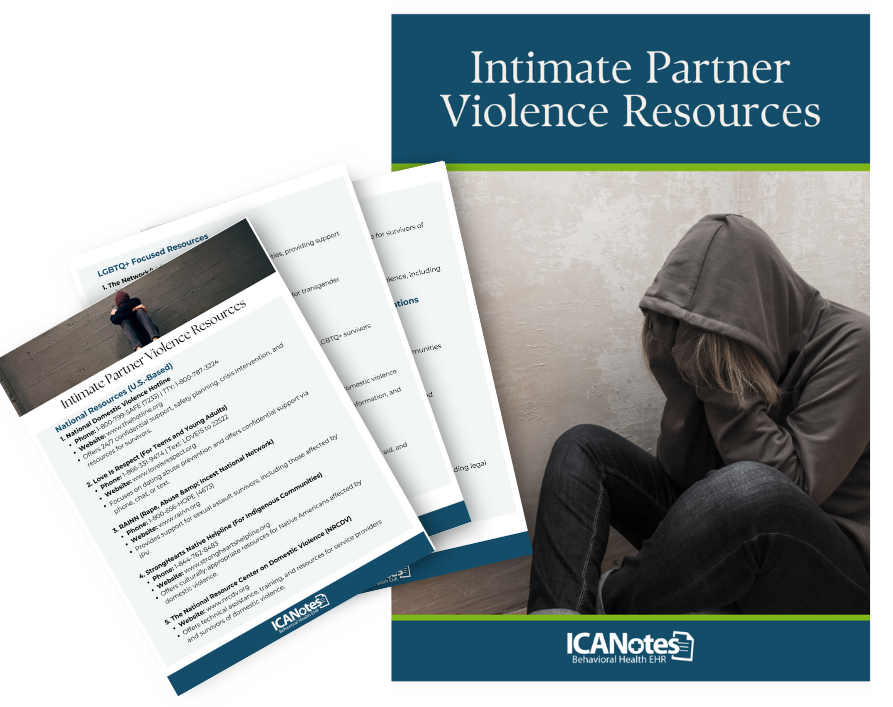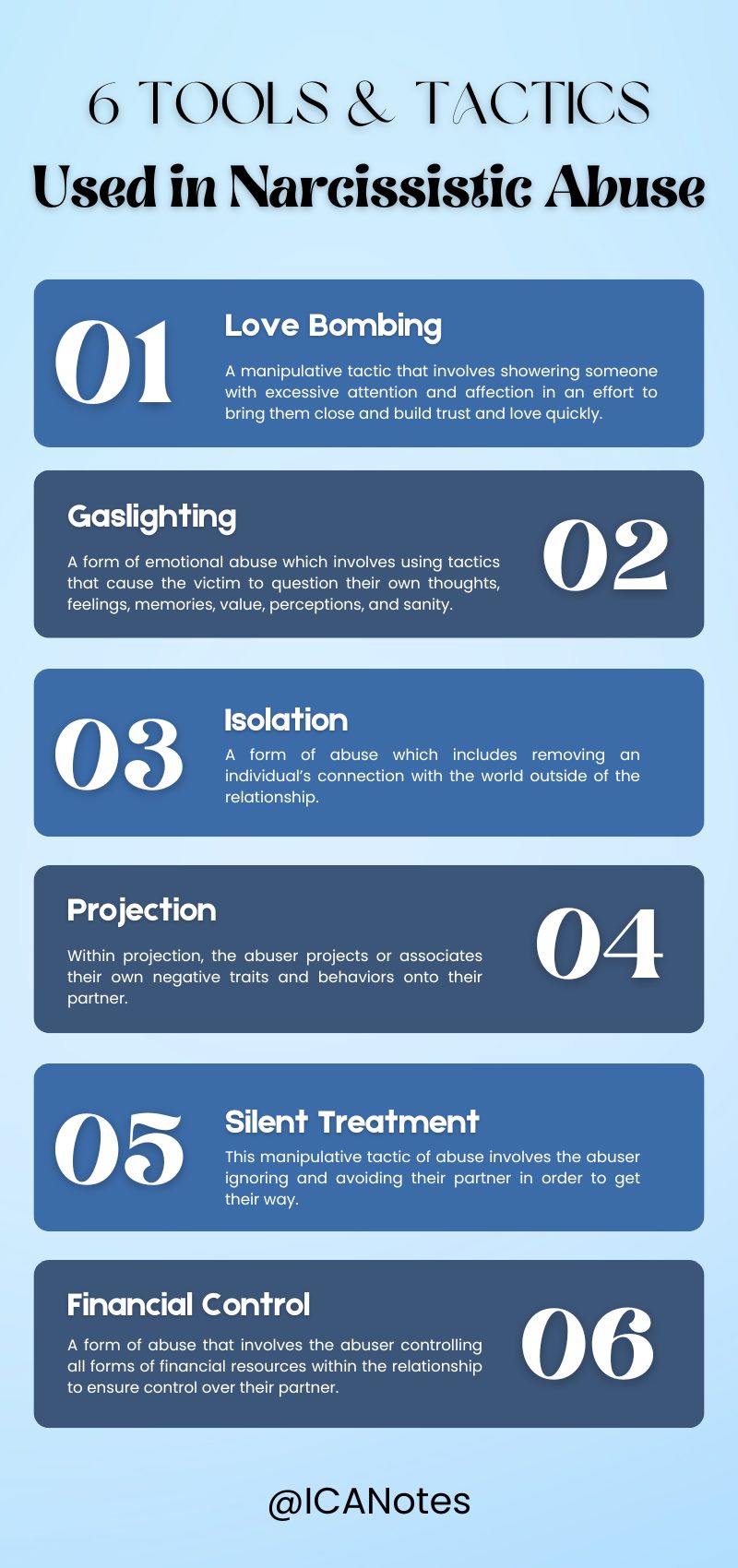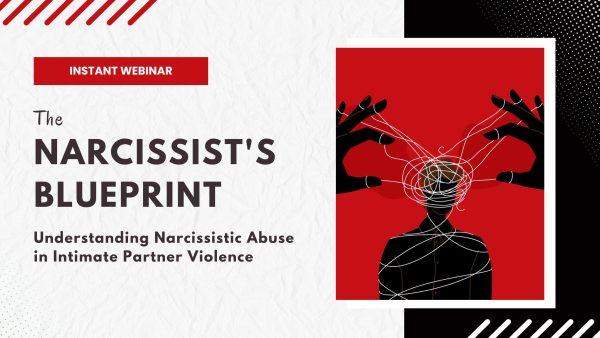
Understanding Narcissistic Abuse Tactics in Intimate Partner Violence
Intimate Partner Violence (IPV) affects millions, leaving victims—41% of women and 26% of men—feeling unsafe in relationships that should offer support and security (1). Narcissistic abuse within IPV introduces an added layer of emotional and psychological harm through manipulation and exploitation, leaving victims struggling to unpack the traumatic experiences they’ve endured (2).
Clinicians working with victims of this abuse need to have a comprehensive understanding of common patterns and destructive tactics that narcissists use to gain control over their partners.
Defining Narcissistic Abuse
According to the National Library of Medicine, “narcissistic personality disorder (NPD) is characterized by a pervasive pattern of grandiosity, need for admiration, interpersonal exploitive behaviors, and lack of empathy, beginning in early adulthood and manifest in a variety of contexts.” This personality disorder can be present in both men and women but is more commonly seen in men (3).
Interestingly, narcissistic abuse in relationships can often be tracked through a common 4-step cycle: love bombing, devaluation, discard, and re-engagement (4). While this cycle, from an outside perspective is relatively easy to spot, individuals in a relationship with a narcissist employing these strategies may find it more difficult to catch on, due to the re-engagement and love bombing meeting an emotional need for them, often convincing them to stay for the “good parts.” This cycle is convincing, and strategic in nature, with its primary purpose being to manipulate, exploit, or subjugate another person.
FREE DOWNLOAD:
Download our comprehensive list of national and local resources available to support survivors of intimate partner violence

Narcissistic Abuse Tactics
A narcissist’s abuse cycle follows 4 primary steps: love bombing, devaluation, discard, and re-engagement. Each step plays a specific role in maintaining control over the victim and perpetuating emotional and psychological manipulation. Within these steps there are a variety of narcissistic abuse tactics employed to facilitate the continued cycle of abuse.
- Love Bombing: A manipulative tactic that involves showering someone with excessive attention and affection in an effort to bring them close and build trust and love in a short period of time. In many cases, victims of love bombing enjoy this attention, which mimics the experiences of ‘love at first sight’ and ‘soul mates’.
- Gaslighting: A form of emotional abuse which involves the abuser using tactics that cause the victim to question their own thoughts, feelings, memories, value, perceptions, and sanity. Through this tactic, narcissists gain control by skewing their partner’s own confidence in themselves, and elevating the abuser’s control.
- Isolation: A form of abuse which includes removing an individual’s connection with the world outside of the relationship. Beginning slow, in the love bombing phase, isolation often begins with the abuser wanting to spend all of their time with their partner. Isolation evolves over time into the abuser making their partner question their other relationships, needing to show loyalty to the abuser over any other relationship to prove their love, and finally, convincing the victims that none of their friends and family would believe them if they disclosed what they had been experiencing.
- Projection: A narcissistic abuse tactic employed as a strategy to further skew a victim’s self of self. Within projection, the abuser projects or associates their own negative traits and behaviors onto their partner. For example, if the victim expresses concern over not feeling connected to their family and friends, the abuser will turn that criticism around, making the victim believe they are isolating the abuser from their friends and family.

- Silent Treatment: This manipulative tactic of abuse involves the abuser ignoring and avoiding their partner as a way to communicate that their partner is not behaving in a way that they approve of. This can be noted through ignoring their partner, or shutting down communication completely when it is initiated.
- Financial Control: A form of abuse that involves the abuser controlling all forms of financial resources within the relationship to ensure control over their partner. This may include controlling money coming in and going out, creating large amounts of debt in their partner’s name, and sabotaging employment to ensure financial reliance on the abuser.
This narcissistic abuse cycle creates a pattern of emotional highs and lows that confuses and entraps the victim, making it difficult for them to break free. Recognizing these steps is crucial for clinicians working with survivors to help them understand the manipulation at play and support their healing process.

Watch our On-Demand Webinar
For clinicians working with survivors of IPV, having a deep understanding of the complexities surrounding narcissistic abuse is essential for providing effective care. This webinar will equip you with the knowledge to recognize narcissistic traits and behaviors so that you can guide your clients through their healing journey.
The Psychological and Emotional Impact of Narcissistic Abuse Tactics
The impact of narcissistic abuse within intimate relationships deeply alter the victim’s sense of self in a variety of ways. Exposure to long term abuse can result in a fundamental shift in an individual’s thoughts, feelings, actions, self-esteem, and personal relationships (5). Intimate partner violence oftentimes begins for victims at an early stage in adulthood, when identity is still being formed, many times before the age of 18 (1). For this reason, as well as the chronic exposure to strategic abuse at the hands of a narcissistic partner, many victims experience a variety of the following long-term effects:
Low Self-Esteem
Due to the insidious nature of narcissist abuse, as well as the directed tactics employed that directly target the victim’s self of self, intelligence, competence, and worthiness, individuals who have experienced this form of abuse are likely to have low self-esteem both during and after the abuse has occurred. This impacts the individual’s life moving forward as they attempt to navigate the world following the abuse, but with the remnants of the internal belief structures about themselves that the narcissist so strategically built.
Relationship Issues
Relationships outside of the abuse are often specifically targeted by a narcissist causing long-term disruption in the victim’s relationships. This can include relationships that were ruptured within the relationship due to distancing and lack of transparency from the victim. This can create a rift in relationships with family and friends that can be incredibly difficult to overcome. Additionally, following an abusive relationship, victims struggle with maintaining healthy relationships with future partners due to their difficulty trusting others, setting boundaries, and managing their low self-esteem and believing they are “worthy” of love.
Mental Health Issues
Narcissist abuse is targeted at their victim’s sense of self, deeply impacting their mental health within the relationship and afterward. Many individuals, who have experienced narcissist abuse show symptoms of trauma, anxiety, and depression. In addition to these diagnosable mental health issues, victims also may experience unpredictable emotional events such as anger outbursts, emotional numbing, mood swings, and difficulty regulating their feelings.
Physical Health Problems
In addition to mental health effects, long-term narcissist abuse can also deeply impact an individual’s physical health, including issues with sleep, muscle tension, and stomach disruption. This can be largely attributed to how are internal experiences like trauma, depression, and anxiety, often manifest in physiological issues. Additionally, victims of abuse may begin engaging in unhealthy lifestyle choices including using drugs or alcohol to cope, neglecting their nutrition needs, as well as their physical health needs.
Narcissistic Abuse Syndrome: Recognizing the Signs and Symptoms
Narcissistic Abuse Syndrome (NAS) refers to the psychological and emotional consequences suffered by individuals in close relationships with narcissists, particularly within the context of intimate partner violence (IPV). While it is not a formal diagnosis, NAS is widely recognized among clinicians and mental health professionals as a complex set of symptoms that arise from prolonged exposure to narcissistic abuse tactics such as gaslighting, manipulation, and emotional exploitation.
Symptoms of Narcissistic Abuse Syndrome
Victims of narcissistic abuse tactics may present with symptoms similar to trauma-related conditions like PTSD, but with distinct characteristics tied to the unique dynamics of narcissistic relationships. Some common symptoms include:
- Chronic Self-Doubt and Confusion: Victims may frequently question their reality, emotions, and perceptions, often feeling confused about their experiences. This is largely due to the gaslighting and manipulation that undermine their sense of trust in themselves.
- Hypervigilance: Victims can become excessively alert and on guard, constantly anticipating the next form of abuse or manipulation. This heightened state of alertness often interferes with their ability to relax or feel safe, even in otherwise secure environments.
- Low Self-Esteem and Worthlessness: Narcissistic abuse systematically dismantles a person’s sense of self-worth. Through repeated emotional assaults, victims may internalize the belief that they are not worthy of love, respect, or kindness, which can perpetuate their cycle of victimization.
- Emotional Numbing and Detachment: Over time, some victims may develop a form of emotional numbness or dissociation as a coping mechanism to shield themselves from the emotional pain caused by the abuse. They may struggle to connect with others or experience joy.
- Intrusive Thoughts and Flashbacks: Just like other forms of trauma, victims of narcissistic abuse often experience intrusive thoughts or vivid flashbacks that replay moments of abuse, making it difficult to move forward and heal.
- Difficulty Trusting Others: Trust issues are common among victims of narcissistic abuse. After being manipulated and exploited by a partner, they may find it difficult to trust friends, family members, or future partners, leading to feelings of isolation.
- People-Pleasing Tendencies: Having been conditioned to prioritize the narcissist's needs above their own, victims may struggle with asserting themselves and fall into patterns of people-pleasing to avoid conflict.
The Long-Term Impact of Narcissistic Abuse Syndrome
Narcissistic Abuse Syndrome can have profound and lasting effects on victims, often shaping their interpersonal relationships and overall mental health. Left untreated, these symptoms can escalate into more severe mental health conditions like depression, anxiety disorders, and complex PTSD (C-PTSD).
It’s crucial for clinicians to recognize these symptoms early, provide appropriate interventions, and foster an environment where victims can rebuild their sense of self-worth and autonomy. Key interventions may include trauma-informed therapeutic approaches, cognitive behavioral therapy (CBT), and eye movement desensitization and reprocessing (EMDR), all tailored to help victims regain their sense of self and navigate the healing process.

Clinician Strategies for Supporting Victims of Narcissistic Abuse Syndrome
Victims of narcissistic abuse in intimate partner relationships may come to you with a need for intervention for complex issues as a result of ongoing psychological manipulation from their abuser. Clinicians working with this population play a critical role in supporting these individuals in various ways.
1. Establishing a Therapeutic Alliance
We know that victims of narcissistic abuse have likely experienced isolation from any supportive relationships as a result of a narcissist's strategy to make their victim reliant on their relationship. Additionally, due to many forms of manipulation, the individual may also struggle with trust in the early days of therapy. For this reason, taking time to build a trusting, therapeutic relationship with your client is an essential first step to ensuring they will be open to all other interventions.
2. Assessment and Identification
While a client may come to you with clear signs of abuse, it is important to fully assess their experiences to ensure the treatment course is effective for each individual. Clinicians can implement assessments that identify the dynamics of the relationship and identify common signs of narcissist abuse, while also coming from a trauma-informed lens of care.
3. Empowerment and Validation
Two experiences that are deeply lacking for clients who come for support as a result of narcissistic abuse are the deep need for empowerment and validation. Overarchingly, clients with this history need to feel heard, understood, believed, and assured that they are “not crazy”. This strong need, which will likely resurge often throughout treatment is a result of chronic abuse and emotional manipulation, causing the individual to doubt themselves.
4. Trauma-Informed Therapeutic Approaches
It is essential to work with a trauma-informed approach when supporting a victim of intimate partner violence. As previously mentioned, many victims of this form of abuse show clear signs of trauma following their experience. The following interventions may be warranted, and should be selected thoughtfully and strategically for each individual, and only used at the hands of trained clinicians in each modality:
-
Cognitive Behavioral Therapy (CBT)
-
Eye Movement Desensitization and Reprocessing (EMDR)
Regardless of the chosen modality, a clinician should focus on assisting their clients with processing their trauma and a pace that feels safe for them
5. Developing Safety and Exit Plans
When your client comes to you for support, they may still be in a relationship with their abuser. Unfortunately, this is common and should not be judged by the clinician under any circumstances. If and when your client decides to leave their abuser, safety must be the primary concern. Creating a safety plan with your client involves thinking through practical strategies that allow for physical and emotional safety throughout the process.
This may include but is not limited to:
-
Identifying safe places
-
Developing a list of safe individuals for support
-
Sourcing local resources for anticipated and unanticipated needs (i.e. shelter, food, legal counsel)
6. Supporting Recovery and Healing
It is important to note that healing from narcissist abuse is not a short or easy process. Clients will need long-term, ongoing support that may hit many bumps along the way. Throughout this long process, clinicians need to encourage continued participation from clients, and be creative in strategies for intervention including, support groups, self-care strategies, journaling, physical and wellness activities, and grief work.
7. Self-Care for Clinicians
Working with victims of abuse is not any easy role for clinicians. There will be times when you have to bear witness to deeply painful and traumatizing retellings of abuse or experience your client returning to their abuser. For these reasons, it is essential for clinicians to stay tuned into self-care strategies that mitigate vicarious trauma, poor boundaries, and burnout. Clinicians in this field should engage in regular clinical supervision, maintain professional boundaries, and find personal outlets for support.
How ICANotes Supports Clinicians Treating Clients Recovering from Narcissistic Abuse and Intimate Partner Violence
At ICANotes, we understand the sensitive and complex nature of treating clients who have experienced narcissistic abuse and intimate partner violence. With over 25 years of experience in behavioral health, we’ve crafted our EHR system to support the unique needs of clinicians working with trauma survivors. We recognize that documenting nuanced patient experiences and delivering trauma-informed care requires precision, empathy, and efficiency.
Our EHR solution is designed by expert clinicians and offers specialized tools to help you streamline documentation, track therapeutic progress, and ensure compliance with legal and industry standards. Whether you’re conducting assessments, tracking patterns of abuse, or documenting the emotional recovery of your clients, ICANotes allows you to do so with ease and accuracy, freeing you to spend more time focusing on providing care.
Let ICANotes help you reclaim valuable time and energy so you can dedicate more attention to supporting survivors on their journey to healing. Our software simplifies your practice management, allowing you to focus on what’s most important — guiding your clients through recovery and helping them rebuild their lives.
Register for a free trial today! (no credit card required)
About the Author

Kaylee, a certified grief counselor and social worker, has dedicated the past decade to reshaping our understanding and support of grief. With experience at a nonprofit hospice, she's empowered individuals to navigate their grief journeys, recognizing that loss extends beyond death. As an author, speaker, and event organizer, Kaylee fosters spaces for acknowledging and embracing life's most challenging moments. Her work has been featured across various media, amplifying voices and broadening awareness of the diverse sources of grief in our lives.


